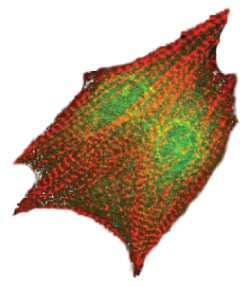What Are Stem Cells?
Our bodies are made of many types of cells, each with a specific purpose. Red blood cells carry oxygen, pancreas cells react to sugar by producing insulin, liver cells break down fat, and so on. Early on in development, however, cells haven’t been assigned a “purpose” yet. These are stem cells.
Stem cells are the building blocks of the body and are unique because:
- They can continually renew and make more of themselves.
- They can become tissue or organ-specific cells with specialized functions: cardiac cells beat in a dish the way they make your heart beat, neurons fire electrical impulses to communicate with each other, etc.

Pluripotent is a term for stem cells that can become any type of cell in the body – more than 200 different types. Induced pluripotent stem cells (iPSCs) are stem cells created through a process in which scientists take a small sample of skin, blood, or fat cells and revert them to a stem cell state. iPSCs were discovered in 2006 by Dr. Shinya Yamanaka, earning him a Nobel Prize for Medicine.
At NYSCF, we use the NYSCF Global Stem Cell Array®, an automated robotic system, to create standardized, high quality iPSCs from many people at the same time, which we ‘biobank’ as a resource for research and can then turn into other cell types.
iPSCs can be made from anyone’s blood or skin samples using Dr. Yamanaka’s method. iPSCs can grow indefinitely in a dish and become any cell type in the body, giving researchers a limitless supply to advance the understanding and treatment of diseases in 3 major ways:
- Disease research: Study how the actual human cells affected by a disease develop and dysfunction, and how that might vary from individual to individual.
- ‘Clinical trials in a dish’: Rapidly and efficiently test drug efficacy and potential toxicity, identifying the safest and most promising drugs to test in clinical trials.
- Cell replacement therapy: Generate the cell types that are affected by a disease, correct their dysfunction, and use these new cells to replace the damaged or dead ones in the patient’s body.
Embryonic stem cells are pluripotent stem cells that come from blastocysts – small clumps of five to seven day-old embryo cells – left over from in vitro fertilization treatments that would otherwise be discarded. They are the early stage cells in the body that give rise to all of our cells. Although iPSCs are now more widely used, embryonic stem cells still serve as a critical reference point for stem cell research.
 Adult stem cells are tissue-specialized stem cells that exist in our bodies for our entire lives and act as an internal repair system. Adult stem cells are excellent for studying and potentially repairing specific tissues, but they can only make the limited types of cells found in the tissue in which they reside. For example, adult stem cells from the liver normally only make more liver cells. Patients who undergo bone marrow transplants receive adult blood stem cells from the bone marrow of a donor, allowing them to form healthy red blood cells, white blood cells, and platelets to treat diseases like blood cancers or sickle cell disease.
Adult stem cells are tissue-specialized stem cells that exist in our bodies for our entire lives and act as an internal repair system. Adult stem cells are excellent for studying and potentially repairing specific tissues, but they can only make the limited types of cells found in the tissue in which they reside. For example, adult stem cells from the liver normally only make more liver cells. Patients who undergo bone marrow transplants receive adult blood stem cells from the bone marrow of a donor, allowing them to form healthy red blood cells, white blood cells, and platelets to treat diseases like blood cancers or sickle cell disease.
SCNT is a method for generating patient-specific embryonic stem cells pioneered by NYSCF.
In this technique, the nucleus of an egg cell is removed and replaced with the nucleus of an adult cell, like a skin or blood cell, from a patient. This technique allowed NYSCF to create the first personalized embryonic stem cell models of disease.
Cord blood banking is a procedure in which cord blood — a rich source of stem cells — is taken from a newborn’s umbilical cord after delivery and used for research or preserved for possible use in a stem cell transplant. Cord blood is a biological product regulated by the Food and Drug Administration.
Cord blood is approved only for use in “hematopoietic stem cell transplantation” procedures, which are done in patients with disorders affecting the hematopoietic (blood forming) system. Cord blood contains blood-forming stem cells that can be used in the treatment of patients with blood cancers such as leukemias and lymphomas, as well as certain disorders of the blood and immune systems, such as sickle cell disease and Wiskott-Aldrich syndrome.
Interested in learning more? Check out this webinar delivered by Dr. Dan Paull, Senior Vice President of Discovery & Platform Development at NYSCF:
Download our PDF guide to stem cells.
Top Image Credit: Tom Rusielewicz, PhD

